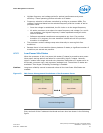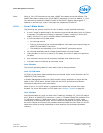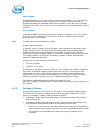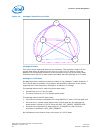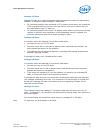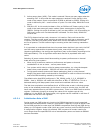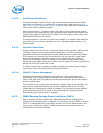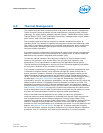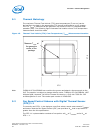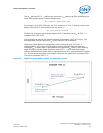
2. Active power-down (APD): This mode is entered if there are open pages when de-
asserting CKE. In this mode the open pages are retained. Power-saving in this
mode is the lowest. Power consumption of DDR is defined by IDD3P. Exiting this
mode is defined by tXP – small number of cycles. For this mode, DRAM DLL must
be on.
3. PPD/DLL-off: In this mode the data-in DLLs on DDR are off. Power-saving in this
mode is the best among all power modes. Power consumption is defined by
IDD2P1. Exiting this mode is defined by tXP, but also tXPDLL (10–20 according to
DDR type) cycles until first data transfer is allowed. For this mode, DRAM DLL
must be off.
The CKE is determined per rank, whenever it is inactive. Each rank has an idle-
counter. The idle-counter starts counting as soon as the rank has no accesses, and if
it expires, the rank may enter power-down while no new transactions to the rank
arrives to queues. The idle-counter begins counting at the last incoming transaction
arrival.
It is important to understand that since the power-down decision is per rank, the IMC
can find many opportunities to power down ranks, even while running memory
intensive applications; the savings are significant (may be few Watts, according to the
DDR specification). This is significant when each channel is populated with more
ranks.
Selection of power modes should be according to power-performance or thermal
trade-offs of a given system:
• When trying to achieve maximum performance and power or thermal
consideration is not an issue – use no power-down
• In a system which tries to minimize power-consumption, try using the deepest
power-down mode possible – PPD/DLL-off with a low idle timer value
• In high-performance systems with dense packaging (that is, tricky thermal
design) the power-down mode should be considered in order to reduce the heating
and avoid DDR throttling caused by the heating.
The default value that BIOS configures in "PM_PDWN_config_0_0_0_MCHBAR" is
6080h – that is, PPD/DLL-off mode with idle timer of 80h, or 128 DCLKs. This is a
balanced setting with deep power-down mode and moderate idle timer value.
The idle timer expiration count defines the # of DCKLs that a rank is idle that causes
entry to the selected powermode. As this timer is set to a shorter time, the IMC will
have more opportunities to put DDR in power-down. There is no BIOS hook to set this
register. Customers choosing to change the value of this register can do it by
changing it in the BIOS. For experiments, this register can be modified in real time if
BIOS does not lock the IMC registers.
4.3.2.1 Initialization Role of CKE
During power-up, CKE is the only input to the SDRAM that has its level recognized
(other than the DDR3/DDR3L reset pin) once power is applied. It must be driven LOW
by the DDR controller to make sure the SDRAM components float DQ and DQS during
power-up. CKE signals remain LOW (while any reset is active) until the BIOS writes to
a configuration register. Using this method, CKE is ensured to remain inactive for
much longer than the specified 200 micro-seconds after power and clocks to SDRAM
devices are stable.
Power Management—Processor
Intel
®
Xeon
®
Processor E3-1200 v3 Product Family
June 2013 Datasheet – Volume 1 of 2
Order No.: 328907-001 59



